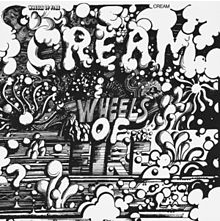
Wheels of Fire was the third album recorded by Cream and was released in 1968.
“Crossroads”
Wheels of Fire was the third album recorded by Cream and was released in 1968. The song on the album titled “Crossroads” was arranged by Clapton as a blues rock adaptation of the original song “Cross Road Blues” by Robert Johnson in 1937. Clapton draws from Johnson by taking the blues timbre of Johnson’s slide guitar accompanied with “piano-style” fingerpicking, but simplifying it and applying it to a typical eighth-note rock rhythm. Interestingly, Clapton’s version follows the I-IV-V twelve-bar blues more clearly than that of Johnson. “Cross Road Blues” is fairly irregular and includes many “deviations from 4/4 and expanded first and second clauses” (Ford 1998). One of the major differences in the two versions is that Robert Johnson’s version sounds like it used some improvisation as well as a looser timbre while Cream plays with a more polished and methodical timbre and sticks to the script, so to speak. Being a band instead of just a solo artist, Cream’s version also has a much thicker texture than Robert Johnson. Cream adds percussion and bass to Johnson’s thin original.
(https://www.youtube.com/watch?v=uvVRcwAmOLQ)
(https://www.youtube.com/watch?time_continue=2&v=PE9HvSdcaL4)
Clapton’s use of the electric guitar to exemplify his spin on the original riff and incorporation of backbeat gives “Crossroads” its rock characteristic. The catchy riff opens the song and is maintained throughout, which is a common attribute of rock music. During Clapton’s lengthy electric guitar solo (1:28-2:10), he uses the technology of amplification, distortion, and effect pedals to create notes that flow together, similar to Robert Johnson’s use of the slide guitar. Clapton would always incorporate blues elements into his guitar solos, he has been quoted saying, “I would always make sure to find some place to put the blues in” (Kellett, 2017).
“White Room”
Although “White Room” was a Cream original, its blues influences are just as present. At the 1:19 mark of the song, Bruce and Clapton start a call and response that emphasizes this perfectly. Bruce calls by singing a line and Clapton responds with a guitar riff. These riffs that Clapton is playing are heavily using the wah-wah pedal to create that distinct “whining” or “lady effect” as Clapton calls it. This whining emulates a brass instrument like a trumpet or trombone, two instruments heavily used in jazz and the blues. Call and response itself was a popular blues technique and when Bruce sings his lyrics with blue notes and waits for the response from Clapton’s whining guitar, strong shades of the earlier delta blues come shining through.
At the end of the song, around the 4:00 mark, Clapton goes into an uptempo guitar solo, a concept new to the music world in the rock genre, again heavily using the wah effect. In this solo, Clapton’s guitar takes on a lot of the characteristics of a muted trumpet. The sheer speed with which he is playing brings up a major advantage of using a guitar instead of a trumpet in this instance. Every time he strums the guitar, a musician playing the trumpet would need to blow out more air. Clapton’s solo is so long and intense that there is no way a trumpeter would be able to get through the whole thing without gasping for air. Rock techniques were borrowed from blues and jazz, but they were vastly improved upon.
Chart Performance
Wheels of Fire peaked at No. 3 on the U.K. Albums chart and No. 1 on the U.S. Billboard Top 200. It became the first ever platinum-selling double album in America, meaning it had over 1,000,000 in units of sales. One of the discs featured live performances and the other was studio-produced showing fans the wide range of talents the power trio possessed. The album was certified platinum not only in the United States, but in Britain and Australia too.
The most popular song from the album was “White Room,” and it did very well on the charts as a single too, peaking at No. 6 in the United States. “Crossroads” got as high as No. 28 on the single releases chart.